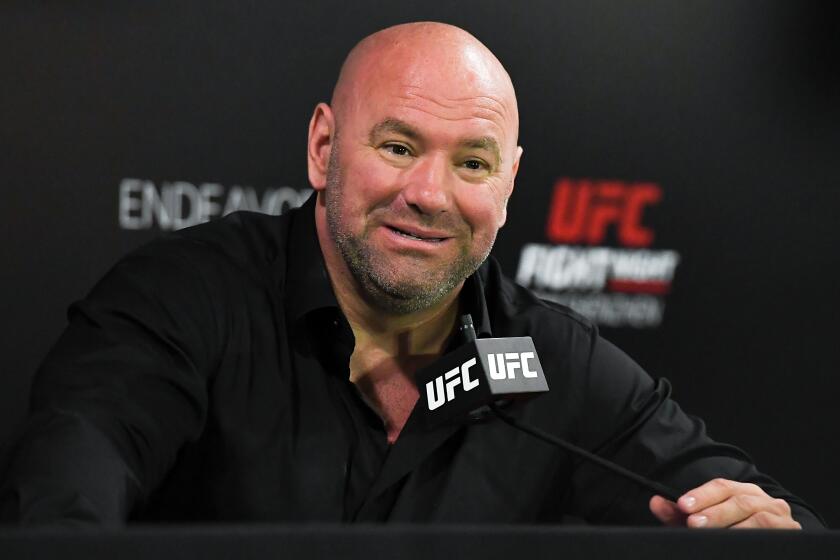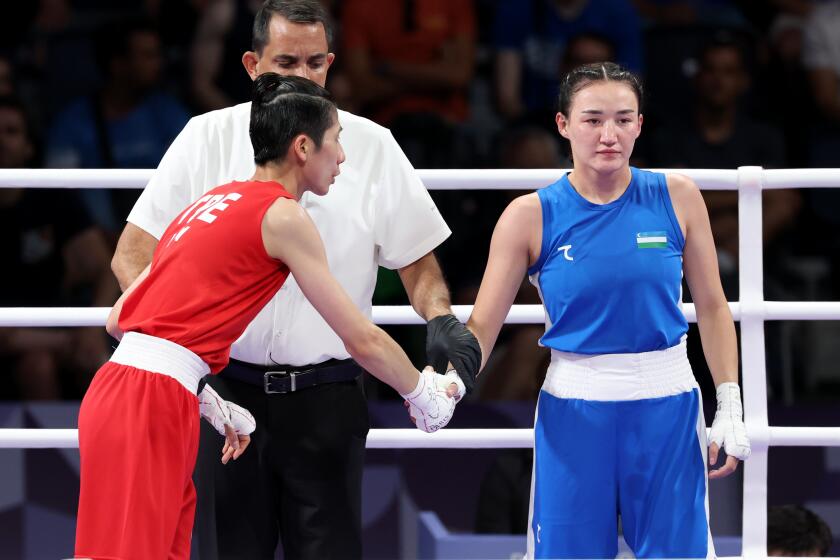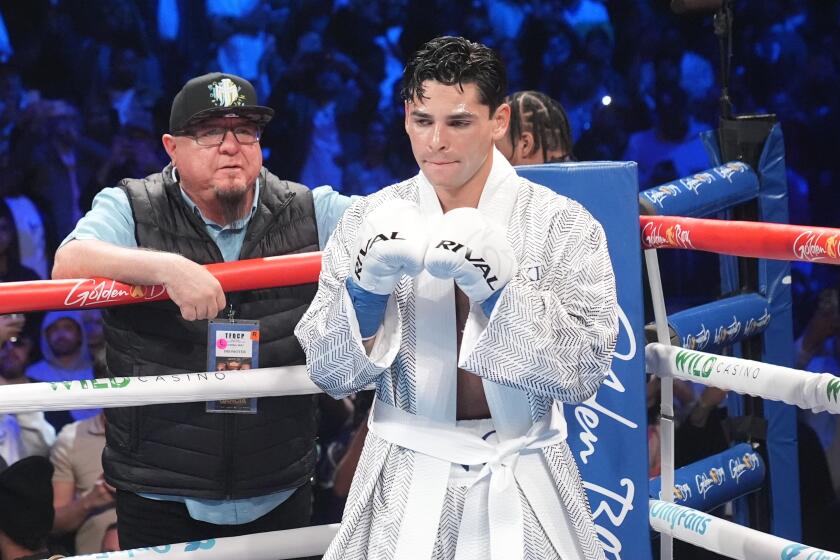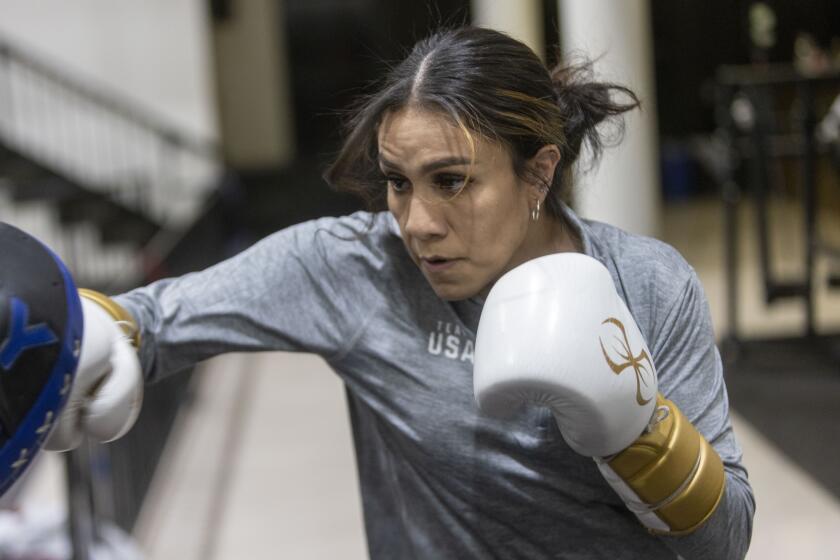Oxnard Teen-Ager Gets a Fighting Chance : Boxing: Robert Garcia is the first to come up through La Colonia club with a good shot at making it as a prizefighter. He talks of growing up in a crowded trailer camp and one day becoming a champion.
Robert Garcia threw a flurry of jabs and uppercuts at a phantom opponent, burning nervous energy while waiting to climb into the ring.
For the first time since the Oxnard high school senior slipped on a pair of boxing gloves more than a decade ago, Garcia’s mother was on hand to watch him fight.
So were two Oxnard city councilmen, the mayor and dozens of barrio youngsters who idolize the 18-year-old prizefighter--and who would give anything to be like him.
Here in the belly of the Great Western Forum in Inglewood, as those who watched him blossom into a promising professional awaited his entry into the ring, Garcia talked last week of one day being champion.
He spoke about growing up in a crowded Oxnard trailer camp, where boyhood pursuits such as shooting marbles and slingshots always took a back seat to boxing.
And he talked about cashing in on his athletic gifts so that his farm worker parents never again would have to stoop in the fields.
“It’s going to happen,” he said softly, as if explaining the inevitable. “Everybody has high hopes for me. I can’t let them down.”
*
In Latino neighborhoods throughout Southern California, where boxing is part religion and part athletic pursuit, the sport is credited with giving disadvantaged youngsters a fighting chance.
Boxing clubs are widely acclaimed for their power to steer boys away from crime and toward discipline, self-respect and responsibility.
La Colonia Youth Boxing Club, where Garcia has trained since he was 8, has earned a reputation as one of the top amateur programs in the state, having produced local, regional and national champions.
But it’s one thing to know how to box. It’s another to make money at it.
Garcia knows that as well as anyone. He knows that careers can be cut short early. And that, in most cases, the prospects of even the most promising fighters can be thwarted.
His father was a Mexican middleweight who wound up a worker in the strawberry fields of Oxnard. His brother was a professional fighter, who won 18 bouts and lost four before retiring. He now works for a local soft-drink company.
Still, Robert Garcia is the first fighter to come up through the club in La Colonia who has a good chance of making a living at boxing, however short-lived that career might be. And he is realistic about his future.
“I know it will only last a little while,” he said. “I’m going to use boxing for whatever I can get out of it.”
The Channel Islands High School student would earn $600 for the Forum fight. Afterward, a Los Angeles promoter would offer him $50,000 to guide his career.
At a time when Garcia’s teen-age interests lean toward getting good grades and playing pool with his friends, the sudden promise of big money is forcing him to make some hard, adult-sized choices about his future.
“I see this as my job,” he said. “A lot of kids go to work after school. I go to the gym. They get paid for what they do; so do I.”
His parents work the strawberry fields of the Oxnard Plain. And in the late afternoon, after 10 hours in the fields, Eduardo Garcia, Robert’s father, mentor and trainer, arrives at a 7th Street gym, where he volunteers to teach young boxers such as his son who are willing to learn.
The small, well-weathered gym is tucked into a back room at the Boys & Girls Club. It contains a single ring and a few punching bags. Its lights are dim and it’s always cold.
The peeling walls are covered with newspaper clippings and photos of former and present champions frozen in menacing poses.
It has been two years since La Colonia Youth Boxing Club members actually have trained in Oxnard’s La Colonia district. The barrio clubhouse is being refurbished and the team is expected to move back by the end of the year.
On a recent rainy evening, the younger boxers trained first, their movements controlled by an ear-piercing buzzer signaling when to rest and when to fight.
Then Robert Garcia stepped into the ring, whacking away at a pair of padded mitts worn by his father. The boxer moved to the heavy bag, delivering a series of gut-wrenching punches designed to punish the midsection. Finally, he made the speed bag dance.
The youngsters dropped to the canvas to inspect the violent, measured rhythm of the club’s first professional. Because Robert Garcia is the oldest fighter, they call him “Grampa.”
“In boxing, you need some basic things,” Eduardo Garcia said. “You need to be able to hit hard, you need intelligence, you need heart, you need discipline and you need to want to be the best.”
Then, without hesitation, he added: “Robert has them all. He was born to fight.”
At home, boxing is a family affair. His mother steams his low-calorie meals, which have no resemblance to the meat and fried foods eaten by the rest of his family. His sister, Chela, makes his boxing trunks. His brother, Danny, helps his younger brother train.
The family lived in a run-down trailer camp for 10 years before moving to a house off Channel Islands Boulevard four years ago.
Boxing photos outnumber family photos on the living room walls of the south Oxnard home. The photos share space with boxing awards and certificates. Garcia’s first set of shoes hang on one wall, tiny leather sandals caked with mud.
“I save everything,” said his mother, Virginia Garcia. “Even his baby teeth.”
Eduardo Garcia was taught to box by Catholic priests in Michoacan, where he grew up farming corn and beans. The 48-year-old immigrated to the United States in the 1960s to pick strawberries.
He taught Robert to fight when the boy was 5. Three years later, Robert Garcia had his first fight. He knocked another boy flat on his back.
Robert said he rarely discusses anything other than boxing with his teacher-father.
But through that process, he said his father has instilled in him the qualities of courage, discipline and integrity. He said his father’s lessons transcend the boxing ring.
“I owe him everything,” he said.
*
On the morning of Garcia’s first professional fight in this country, he and his father and his brother Danny arrived at the Forum weigh-in an hour early.
Boxers can’t fight professionally in this country until they are 18. At 17, Garcia’s Los Angeles manager, businessman Nori Takatani, arranged for the featherweight to fight in Japan.
Three fights, three knockouts. In the first two fights, his opponents’ handlers literally threw in the towel.
Other boxers began to trickle into the Forum last Monday as Robert was trying to catch the first glimpse of his opponent.
The boxers were mostly young Latino and black prizefighters in sweat suits and sneakers, represented mostly by middle-aged men in ties and three-piece suits. Garcia’s opponent was a veteran Mexican fighter by the name of Francisco Arroyo, a flat-faced boxer with a pulp of a nose and a reputation for being able to take a punch.
He would need that quality this night.
The wait for the fight to start was a long one for Garcia and his family. But when the waiting was over--when the moment to which he had dedicated nearly his entire life had arrived--Garcia danced in the ring, draped in a black poncho with gold trim.
He waved to young La Colonia boxers yelling his name, and blew a kiss to his mother and sisters.
By the third round, Arroyo was in deep trouble. A nasty cut had opened under his right eye and Garcia was hitting him at will. The Forum crowd had picked up on a chant started by his screaming sisters: “Robert! Robert! Robert!”
Arroyo did not answer the bell for the sixth and final round.
Back in the locker room, Garcia held a short news conference in English and Spanish. Even his father answered a few questions for reporters from an Oxnard-based, Spanish-language television station.
“I give my son a 10,” he told the reporters. “Like any proud father.”
Back in the stands, Garcia was mobbed by his young fans. They patted him on the back and asked him to sign his autograph.
“You’re our future,” one of the young boxers told him. “I want to be just like you.”
More to Read
Go beyond the scoreboard
Get the latest on L.A.'s teams in the daily Sports Report newsletter.
You may occasionally receive promotional content from the Los Angeles Times.










